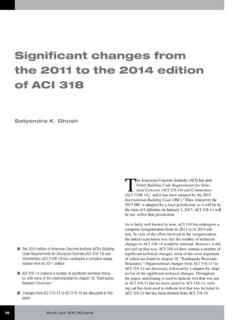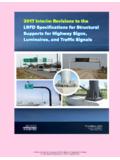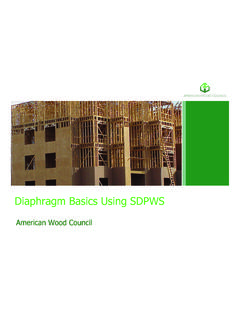Transcription of Significant Changes to the IRC – 2012 Quick …
1 Significant Changes to the IRC 2012 Quick reference Sheet Section/Topic 2009 IRC 2012 IRC Notes/Additional Comments Scope and Administration (Chapter 1) Fences Exempt from Permit Modification: Fences up to 7 feet high are now exempt from permit requirements. Fences not over 6 feet (1829 mm) high Fences not over 7 feet (2134 mm) high. This will be governed by zoning, most will limit to 6 . change due to the fact that 6 foot boards are generally raised off the ground a few inches for typical wood fence installations. Definitions (Chapter 2) R202 Definitions, Structural Composite Lumber Addition: Definitions for structural composite lumber have been added to Chapter 2.
2 Structural members manufactured using wood elements bonded together with exterior adhesives. Examples of structural composite lumber are: Laminated veneer lumber (LVL) Parallel strand lumber (PSL) Laminated strand lumber (LSL) Oriented strand lumber (OSL) New provisions in the floor, wall, and roof framing chapters of the (IRC) recognize structural composite lumber and reference a new standard in the code, (ASTM D 5456-09) Building Planning and Construction (Chapters 3-10) Wind Design Criteria Modification: Revisions to the section titles and the text clarify the intent and application of the wind provisions.
3 The prescriptive provisions related to wind loads apply to buildings in regions with a wind speed of less than 110 mph. New map added to specify wind designs required and wind speed regions There are Significant Changes to the Seismic Design Category map [Fig (2)] despite not being noted in the Significant Changes book. This will impact a seismic design in Washington Revisions to this section make it clear that the wind limitations only apply to elements of the building that resist wind loads. protection of Openings in Windborne Debris Regions Modification: Windborne debris regions are now defined in a new map.
4 Figure (Map) (4)C added Not Significant to WA. A new map delineates the various windborne debris regions in the hurricane-prone areas of the Atlantic and Gulf coasts. Seismic Provisions Clarification: The general rule and exception for application of the seismic provisions to buildings have been replaced by separate rules to clarify intent. Seismic provisions and list created and Exceptions taken out. It is implied as accessory structures are subject to IRC req s. Removed the exception and creating separate rules for one- and two-family dwellings and townhouses. Table Minimum Uniformly distributed Live Loads Modification: Terminology related to live loads has been updated with consistency with ASCE 7-10 and footnotes revised to clarify the application.
5 Live load information updated for uninhabitable attics with limited and without storage. Applies to stick-built and truss attics. Attics other than habitable attics are now labeled uninhabitable attics for consistency with the 2010 edition of the ASCE 7 standard. Exterior Walls Modification: Minimum clearances to lot lines have been reduced from 5 feet to 3 feet for non-rated exterior walls when the dwelling is protected with a fire sprinkler system. 3 feet Table (2) added Exterior Walls Dwellings with Fire Sprinklers A footnote has been included in this new table that would appear difficult to track/enforce once a subdivision is completed.
6 Would most likely be regulated in the plat 2012 IRC permits non-rated walls that are not less than 3 feet from the lot line, which is the new threshold for exterior wall construction, projections, openings and penetrations. See Footnote (a), Table (2), developments with allowed with 1 hour rated wall (ASTM E-119 or UL 263) dedication /CC&R s zero lot line applications. Parapet Exception Modification: When a parapet is not installed, openings and penetrations of the roof are no longer permitted within 4 feet of the separating wall between townhouse dwelling units. Exception statement added: No openings in the roof within 4 feet of the common walls.
7 Important to note this is when parapet is not installed. The code specifically prohibits any openings in or penetrations through the roof in a location within 4 feet of the common wall separating the dwelling units. Garage Opening Protection Modification: Doors between garage and dwelling unit require self-closing devices Text added: equipped with a self-closing device. It always used to be this way, this is a reversion to the 2006 IRC provisions Doors from the garage to the residence now require self-closing devices. R303 Mechanical Ventilation Modification: When used for satisfying the ventilation requirements for dwellings, mechanical ventilation must now comply with new provisions in Section M1507 for whole-house ventilation of habitable rooms and local exhaust of bathrooms.
8 Adjustments to Exceptions for both Habitable Rooms and Bathrooms. mechanical ventilation added. Definitions of Local Exhaust and Whole House Mechanical Ventilation System added. The design criteria for mechanical systems have now been removed from the building planning provisions of Chapter 3 and new provisions have been added to section M1507. Mechanical Ventilation. Be sure to review SBCC amendments to M1507. Ventilation Intake Opening Modification: The minimum vertical clearance between a contaminant source of an outdoor air intake has increased from 2 feet to 3 feet.
9 2 feet (610 mm) Changed to 3 feet (914mm) Intake openings should be located a sufficient distance from contaminated sources. Hazardous Locations for Glazing Clarification: The provisions for hazardous locations related to the installation of glazing has been reorganized for ease of use and consistent application. Each item has been placed in separate subsection and given descriptive title. Subsections titled: Glazing in Doors Glazing Adjacent Doors Glazing and Wet Surfaces Revisions to the text eliminate conflicts and ambiguous language, and bring IRC provisions into agreement with IBC requirements.
10 Glazing and Wet Surfaces Clarification: Separate provisions regulating glazing near tubs and swimming pools have been consolidated into this one subsection section. Subsection added Glazing and Wet Surfaces Combined requirements for tubs and swimming pools into single subsection to remove redundant language regarding the application of safety glazing. Glazing Adjacent Stairs and Ramps Modification: The rule for the minimum height above a tread at the side of a stairway is now 36 inches to correspond to the height of a guard. Other 60 inches (1524 mm) 36 inches (914 mm) measured horizontally from the walking surface.








